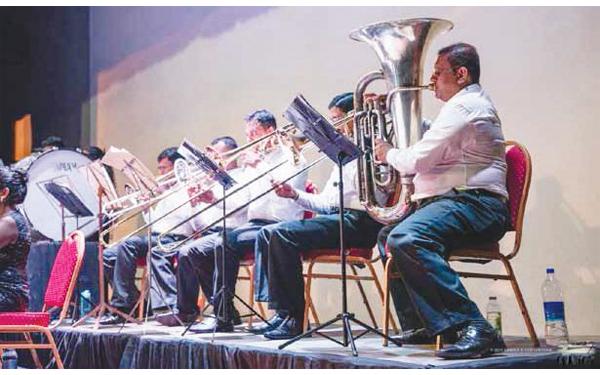
In this article Nuwan Gunawardana, Trombonist of the Gustav Mahler Orchestra of Colombo, introduces the Brasswind instruments of the orchestra.
Brasswind instruments produce sound by vibrating an air column using their lips. Roots of Brasswind instruments can be traced back to the prehistoric eras. The very first Brasswind instruments were animal horns, tusks and shells. With expansion and upgrades, now we have many varieties of Brasswind instruments. Generally, the main three sections of a brass instrument are the mouthpiece, the tube with its length changing system and the Bell.
Compared to other metals, being a more malleable, corrosion resistant and light weight are the reasons for using brass to manufacture these instruments.
The Trumpet, Trombone, French Horn and Tuba are the most common or the major instruments of an orchestra. But apart from those, we can see brass instruments in orchestras such as the Wagner Tuba, Alto Trombone, Piccolo Trumpet and many more.
Trumpet
The Trumpet is arguably the most famous brass instrument. It is considered as an instrument of Gods and Kings because of its use in ancient times. The Tromba and Clarino are a few other names for trumpet. The mother instrument of trumpet is the bugle and it was used to give war signals or the bugle calls.
In the 16th century, the Natural trumpet or the Baroque trumpet used in music which only played in notes of harmonic series. But later, they used different interchangeable pipes for different pitches. Haydn used a natural trumpet with a few keys like a woodwind instrument to play certain notes of his works.
The valve revolution came in Romantic period. Bb trumpet is used mostly in orchestral work but there are many of C, Eb or piccolo trumpet works too. Cornets, The Flugel Horn are different versions of the trumpet. Nowadays, the trumpet is used in many genres such as Pop, Funk and Jazz. The Rotary trumpet is more famous and is more used than the valve trumpet among the orchestral musicians because of its tone.
The trumpet is a transposing instrument and the C of the trumpet in B flat is equal to the Bb of piano. Gustav Mahler’s Symphony No. 05, the Brandenburg Concerto No. 2 by Bach and Hummel’s Trumpet Concerto in Eb are some famous orchestral works highlighting the trumpets.
 Trombone
Trombone
The Trombone is an instrument which uses a slide to change its note positions. That makes some techniques easy on the trombone such as Glissando and vibrato (slide). But since there are no positions marked on the slide, should have a good practice to play in pitch.
The Trombone is an expansion of the Sackbut. The Sackbut and Trombone were used in church music. But it became famous in orchestral music after Mozart used it to his operas such as Idomeneo, Don Giovanni, and Die Zauberflöte. In 1808, Beethoven was the first composer to use the trombone in his Symphony No. 5 in C minor. Tenor and Bass trombones are the ones which are used mostly in orchestral music.
The trombone is a non-transposing instrument and music for the trombone is usually written on the Bass clef but we can see some music written on tenor clef too.
French Horn
“The sound of the horn is the soul of the orchestra” – Robert Schumann
The French horn is developed with the hunting horn which is used for fox hunting in France. After it became a musical instrument, interchangeable different pipes for different pitches were added. lately. Nowadays, French horn has rotor valves and levers to change its length and play different notes with the left hand.
The right hand will be inside the bell and it’s not just used to hold the instrument, but also to changing the notes and tone. The French horn is also called ‘the horn’ or the ‘F horn’ among Western Classical Musicians. The French horn is a transposing instrument. Playing a C of horn in F does sound a perfect 5th below, F of piano. The Horn Calls of Don Juan by R. Strauss, the Symphony No. 05, Movement III - Scherzo, Corno Obligatto by Gustav Mahler and the Horn Solo of P.I. Tchaikovsky’s Symphony No.05 - Movement II are a few famous orchestral French Horn works.
 Tuba
Tuba
Tuba is the biggest member of the brass family and its stretched tube length is approximately 18 feet long. It is the lowest voice of the brasswind sections such as miilitary bands, brass bands and brass ensembles. There are Bass and Contrabass tubas in the key of BBb, CC, Eb and more but the BBb tuba is the mostly used in orchestral works. Tuba is placed on players lap but when marching it’s strapped to the body. There are tubas with rotary and piston valve systems. Tubas are written in Bass clef octave higher.
The Bass Tuba Concerto in F Minor by R. Vaughan Williams is considered as the first-time which Tuba was performed as a solo instrument. Bruckner often used the Tuba along with the Wagner Tubas to construct some of the most beautiful passages in his symphonies.
